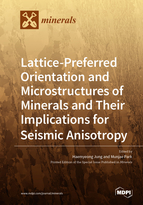Lattice-Preferred Orientation and Microstructures of Minerals and Their Implications for Seismic Anisotropy
A special issue of Minerals (ISSN 2075-163X). This special issue belongs to the section "Crystallography and Physical Chemistry of Minerals & Nanominerals".
Deadline for manuscript submissions: closed (29 January 2021) | Viewed by 27215
Special Issue Editors
Interests: lattice-preferred orientation; olivine; serpentine; amphibole; deformation fabrics; seismic anisotropy; high-pressure experiments; rock deformation; microstructures; earthquake-triggering mechanisms
Interests: lattice-preferred orientation; fluid inclusion; mineral textures; geochemistry; geochronology
Special Issue Information
Dear Colleagues,
Lattice-preferred orientations (LPOs) of minerals develop in the crust and mantle when rocks are deformed under high-pressure and high-temperature conditions. The LPOs of minerals are important for interpreting seismic anisotropy, which is observed worldwide in the crust and mantle, and to understand the internal structure of the deep interior of Earth. There have been major advances in measuring the LPOs of minerals during the past few decades using FE-SEM–EBSD systems. Characterization of microstructures, including LPO, grain size, grain shape, and misorientation has become an important tool in unravelling deformation conditions, deformation histories, kinematics, and seismic anisotropies in the crust and mantle. We welcome papers that describe LPOs and deformation microstructures of minerals and rocks in the crust and mantle, and that give fresh insight into how LPO and microstructures develop and evolve through time, reflect deformation conditions, and influence large-scale geodynamic processes. We encourage contributions from field observations, laboratory experiments, and numerical modeling on geologic materials over a wide range of conditions, length scales, and time scales.
Prof. Dr. Haemyeong Jung
Dr. Munjae Park
Guest Editors
Manuscript Submission Information
Manuscripts should be submitted online at www.mdpi.com by registering and logging in to this website. Once you are registered, click here to go to the submission form. Manuscripts can be submitted until the deadline. All submissions that pass pre-check are peer-reviewed. Accepted papers will be published continuously in the journal (as soon as accepted) and will be listed together on the special issue website. Research articles, review articles as well as short communications are invited. For planned papers, a title and short abstract (about 100 words) can be sent to the Editorial Office for announcement on this website.
Submitted manuscripts should not have been published previously, nor be under consideration for publication elsewhere (except conference proceedings papers). All manuscripts are thoroughly refereed through a single-blind peer-review process. A guide for authors and other relevant information for submission of manuscripts is available on the Instructions for Authors page. Minerals is an international peer-reviewed open access monthly journal published by MDPI.
Please visit the Instructions for Authors page before submitting a manuscript. The Article Processing Charge (APC) for publication in this open access journal is 2400 CHF (Swiss Francs). Submitted papers should be well formatted and use good English. Authors may use MDPI's English editing service prior to publication or during author revisions.
Keywords
- lattice-preferred orientation
- deformation microstructures
- seismic anisotropy
- SEM–EBSD
- fabrics
- rock deformation
- crust and mantle
- high pressure
- mantle flow
- geodynamics







